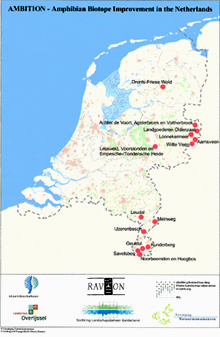 |
Ambassador profile
|
||
| Name: | Roelof Heringa | |
| Function: | Project manager & international affairs | |
| Country: | The Netherlands | |
| E-mail: | r.heringa(at)staatsbosbeheer(dot)nl | |
| Tel: | +31 57074 7100 | |
Organisation profile
|
||
| Organisation: | Staatsbosbeheer (lead partner of the project) | |
| www: | www.staatsbosbeheer.nl | |
| E-mail: | info(at)staatsbosbeheer(dot)nl | |
| Tel: | +31 30692 6111 | |
| Established: | 1899 | |
| Category: | Governmental organisation | |
| Number of staff: | In total > 900 persons | |
 |
| Project profile | |||
| Project name: | |||
| Location: | |||
| Land area: | 13,561 ha | ||
| Natura 2000 ID: |
|
||
| www: | www.life-ambition.com | ||
Priority species focused by the project (The species are also on the national Red List: Triturus cristatus (vulnerable), Bombina variegata (severely threatened), Alytes obstetricans (vulnerable), Hyla arborea (threatened) and Pelobates fuscus (threatened).)
|
|||
| Species code | Latin name | Common / local name | |
| 1166 | Triturus cristatus | Kamsalamander | |
| 1193 | Bombina variegata | Geelbuikvuurpad | |
| Annex IV | Alytes obstericans | Vroedmeesterpad | |
| Annex IV | Hyla arborea | Boomkikker | |
| Annex IV | Pelobates fuscus | Knoflookpad | |
| Some habitats focused by the project (* indicates priority habitats) | ||
| Habitat code | Common / local name | |
| 3110 | Oligotrophic waters containing very few minerals of sandy plains (Littorelletalia uniflorae) | |
| 6110 * | Rupicolous calcareous or basophilic grasslands of the Alysso-Sedionalbi | |
| 6230 * | Species-rich Nardus grasslands, on silicious substrates in mountain areas (and submountain areas in Continental Europe) | |
| 7110 * | Active raised bogs | |
| 7220 * | Petrifying springs with tufa formation (Cratoneurion) | |
| 91D0 * | Bog woodland | |
| 91E0 * | Alluvial forests with Alnus glutinosa and Fraxinus excelsior (Alno- Padion, Alnion incanae, Salicion albae) | |
| Stakeholder profile | |||||
| Stakeholder activity in the management planning process: | |||||
| Stakeholder group | activity level | ||||
| hi ← → nil | |||||
| Local Government | |||||
| Central Government | |||||
| Scientists | |||||
| Private landowners | |||||
| Green NGOs | |||||
| Private sector | |||||
| Recreational groups | |||||
| Stakeholder success stories | |
|
AMBITION The project is focused
on the realisation of habitat improvement for the threatened species
as mentioned above. The project team aims at finishing these works in
2007 (2008 at the latest). In the mean time we also invite local stakeholders
and authorities to visit the project sites and to learn about the project
goals. |
|
| Photo credit: Wilbert Bosman, Roelof Heringa, Gerrit ten Tije. |
| Communication profile | |
| Activities and products for the communication of Natura 2000
|
|
| Events | |
|
|
| Event frequency | |
|
|
| Use of seasonal workers / volunteers | |
|
|
| Kind of work / volunteering opportunities | |
|
|
| Communication literature produced | |
|
|
| Communication target groups | |
|
|
| The organisation has a dedicated communication strategy for Natura 2000 | |
|
|
| Description of communication strategy | |
|
|
| The communication materials are produced | |
|
|
| Site involved in joint working / networking | |
|
|
| Details of joint working / networking activity | |
|
|
| Key site management issues: | |
|
Actions involve both the restoration and development of some hundreds of ponds and development of adjoining land habitat.
|
|
| Integration of Natura 2000 in overall site management: | |
|
To guarantee sustainable habitat improvement we focus mainly on Natura 2000 areas which are recently designated under the Habitat Directive (article 4 of Directive 92/43/EEC) as Special Areas of Conservation (SACs) for Triturus cristatus and Bombina variegata.
|
|
| Key site management objectives: | |
|
The main objective
is to develop viable meta-populations of five amphibian species named
on Annex II (and Annex IV) of the Habitats Directive which will be achieved
through restoration and improvement of habitats. For the severely
threatened Bombina variegata this project should firstly conserve
the remaining populations and might lead to further increase. For the
other species creation of strongholds of sufficient size as well as
the development of meta-population structure are the main objectives.
|
|
| Stakeholders targeted as part of management action: | |
|
This project is based on a cooperation between different management authorities. Partners will work closely together adopting a three-step strategy as followed in Dutch species protection plans. The partners in this project are:
|
|
| Description of work carried out / methods and methodology: | |
|
For the realisation of the habitats for the different species pools have been created or restored, but also land habitat with e.g. shrub planting, creation of zoom-vegetation and rough stone-walls. Dependent on the specific species the shape of pools differs in depth and surface. In the south of Limburg the pools are made with a concrete bottom.
|
|
| Results of action and activities: | |
|
Within the project the beneficiary has to establish agreements with the other partners about the realisation of the project. Partners work together in the project team and share knowledge and working experiences.
|
|
| Indication of budget allocation for these tasks: | |
|
The total budget is € 1.3 million.
|
|
| Financial overview | |
| European funding: | |
|
The European funding is 50 % of total budget (Life-Nature)
|
 |
 |
 |
 |